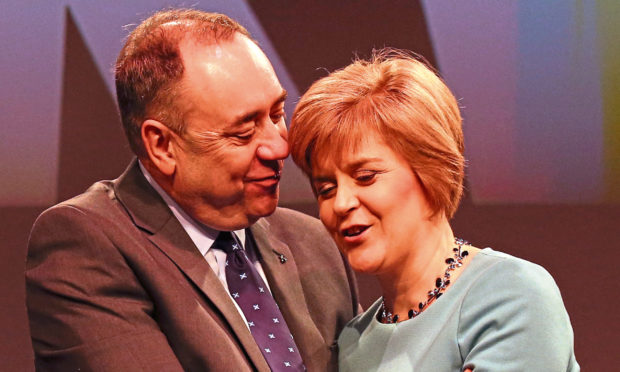There is something Greek about the story of Salmond and Sturgeon – the mentor falling out with the protégé.
A classic tragedy in three acts which will ruin them both.
The first act is Salmond’s rise and his patronage of Sturgeon.
She was made an insider in Salmond’s court by the age of 20 – an astonishing move in retrospect, alienating her from colleagues who envied her early success.
She repaid the compliment by mimicking his style.
Not just the jabby hand gestures, the jutting chin and menace in her public delivery, but a cold ruthlessness in private.
Salmond’s ascendancy was built on the bodies of enemies like Margo MacDonald, Jim Sillars, Alex Neil and Kenny MacAskill.
The party was split between fundamentalists and gradualists – Salmond was the latter, in favour of devolution as a stepping stone to independence
The Salmond machine honed its media savvy and professionalism by first sabotaging party rivals, and then moving on to rival parties.
Sturgeon knew and saw it all and mentally washed the knives late at night to keep them spotless.
The second act begins with Salmond’s return to the leadership in 2003 with Nicola as his deputy.
From this would come a new determination to succeed, resulting in 2007’s election won by a whisker, and 2011’s landslide.
They were in government, cunningly negotiating minority rule thanks to Tory support and the extended concussion felt by Labour at its loss of power.
And then winning the chance for an independence referendum.
From a party with 5% support in 1990 to an all conquering force 21 years later – they had come of age spectacularly.
Yet here the rot sets in.
The mentor’s creed had been that independence was possible and would result in plenty of money for social policy.
The protege liked this, genuine in her belief that nationalism would bring social justice.
However, Sturgeon began to see that the certainty of Salmond’s sermons was not matched in private.
He was more right-wing in office then she would like – but also more indulgent, more pompous.
There was an entitlement which didn’t sit well with Sturgeon’s sense of meaningful public service.
This was tolerable until the referendum campaign, when it became clear that much of what Salmond had asserted about economic matters did not stand up to scrutiny.
Worse, that his approach to the massive business of altering the status of a country was casual, almost disinterested.
It is a classic PR move when something big happens to trump it with something new.
Thus, Salmond resigned within hours of losing the referendum, shifting the story from an analysis of where he had gone wrong, to a tale of what he would do next.
We open the Third Act on Salmond skipping as he moves through the House of Common on the first day of the 2015 parliament.
Not a care in the world, back where he belongs but already a thorn in Sturgeon’s side, going off script for his own publicity (the very crime that he had punished others for in the early 1990s).
By this time Sturgeon knew the scale of the hole at the heart of the Indy case, much as she already knew how her predecessor’s time in office had achieved little in terms of improving Scotland.
She had two tasks: To set policy in a direction it would contribute to social justice, and to fix the case for independence.
In both she was hampered by having to maintain continuity with the Salmond years.
The real tale is how the modern SNP is torn asunder, between Salmond loyalists and progressives.
This time Salmond is the fundamentalist, the enemy within, mocking the pragmatism of the leader.
The FM says she will announce a plan for Indyref2 soon.
But who will lead it?
The hero of middle-aged white men, now given to saying the SNP should be more like the DUP?
Or the woman who dared challenge him?
I suspect it is curtains for both.



